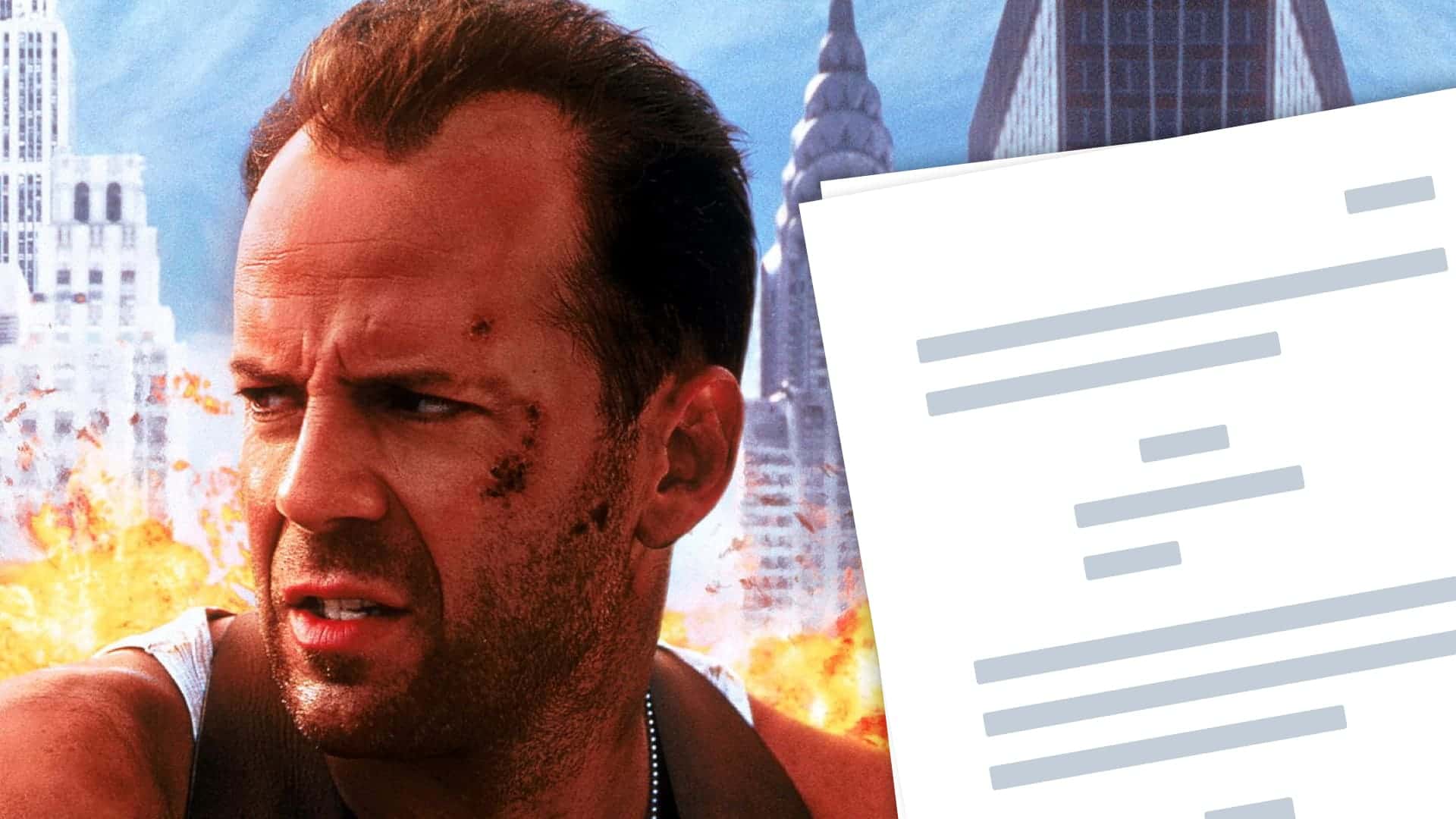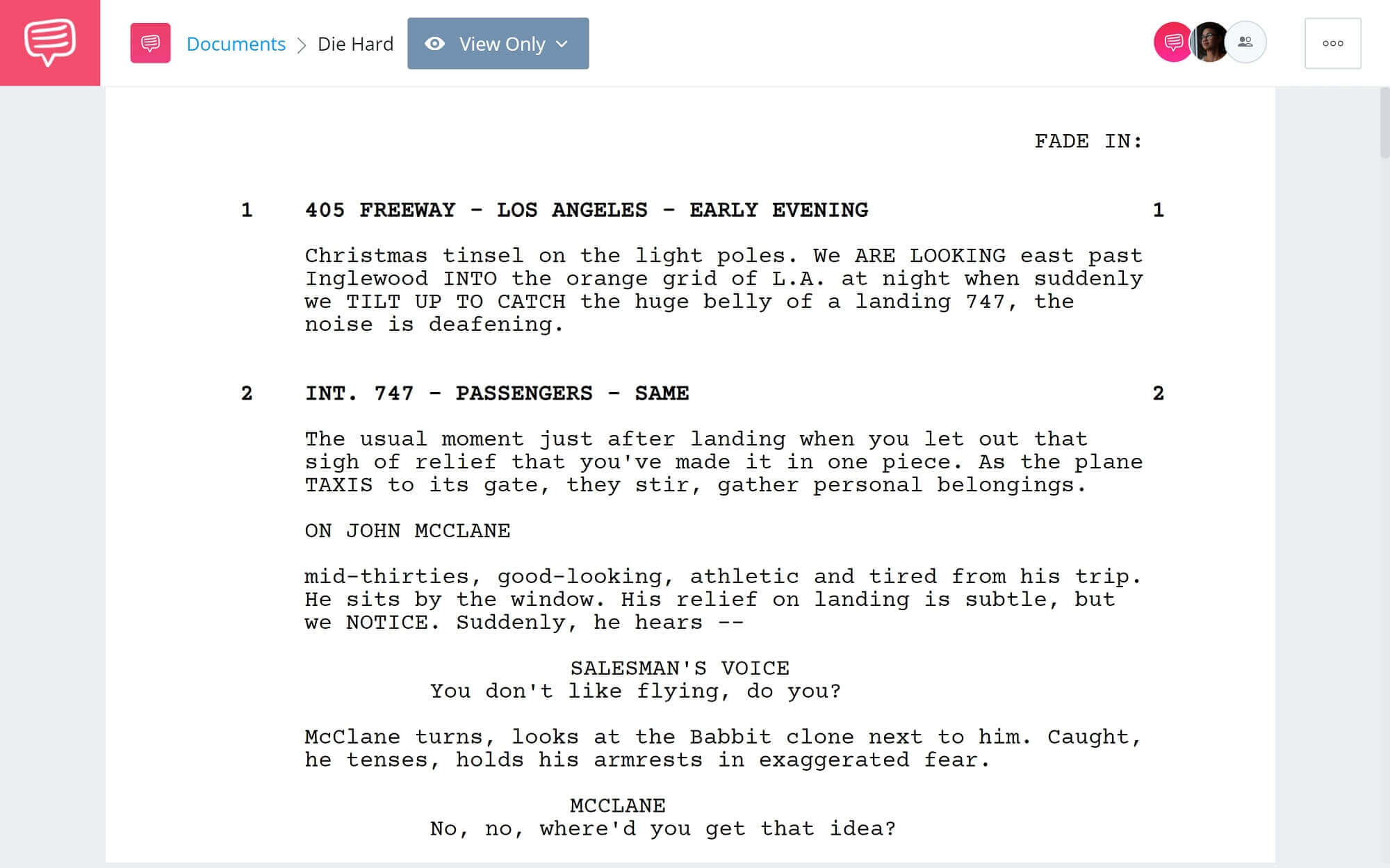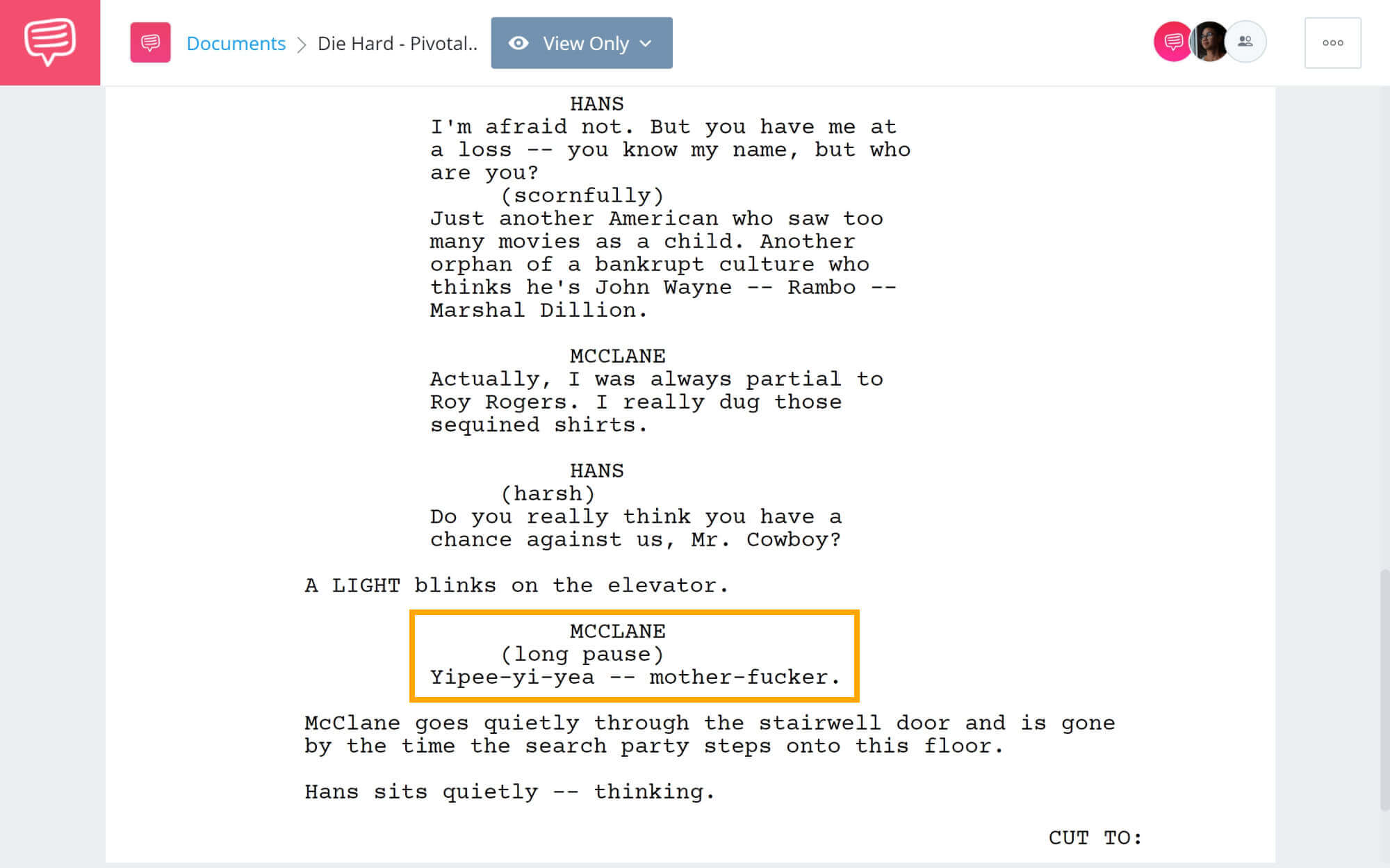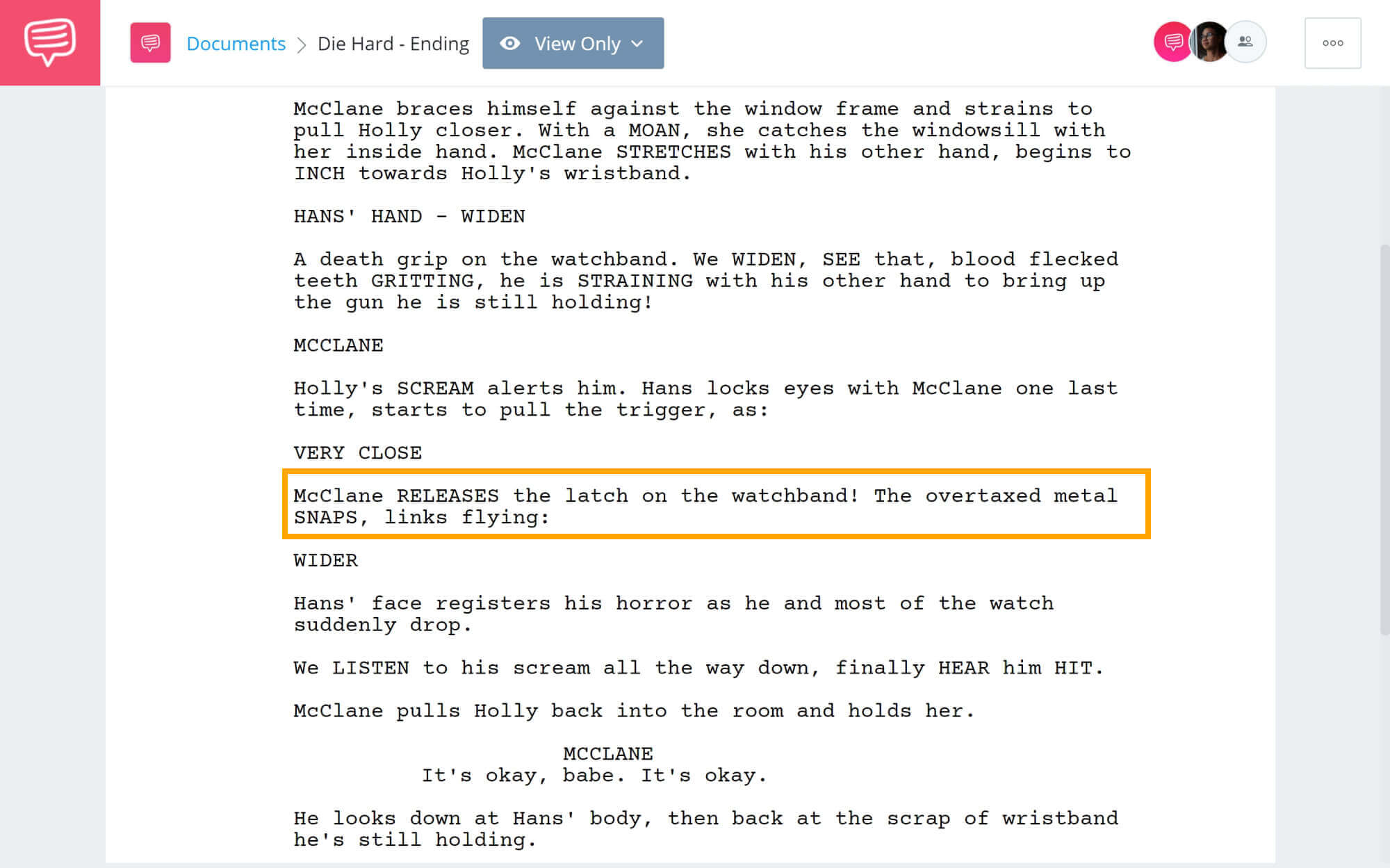Before John McClane was the quintessential action hero, he was just part of someone’s imagination on the page. Die Hard set the template for a generation of action movies that followed. But what made this particular story so special? Let’s journey through the air ducts for a complete Die Hard script analysis complete with the quotes, characters, and ending that made it an instant classic.
WHO WROTE Die hard SCRIPT?
Written by Jeb Stuart and Steven E. de Souza
Jeb Stuart was in a dire financial situation when Lloyd Levin, head of development at the Gordon Company at the time, offered him a job to write a screenplay based on the 1978 novel Nothing Lasts Forever. Stuart struggled with finding the core of the story, but after a near-death experience, he realized it should focus on a man trying to reconcile with his wife.
Later, Steven E. de Souza was brought onboard for a rewrite. He approached the story as though Hans Gruber was the protagonist. De Souza continued writing scenes they could film early on in the film’s production when Bruce Willis was filming Moonlighting simultaneously.
STORY BREAKDOWN
STRUCTURE OF THE DIE HARD SCREENPLAY
Here is a quick Die Hard synopsis based off its screenplay:
Exposition
Before the Die Hard plot kicks off, we see John McClane out of his element. His in a limo with Argyle, who’s particularly nosy and inquires into his on-the-rocks marriage. We learn everything about why McClane is in L.A. and what he hopes to achieve while there.
Inciting Incident
Die Hard has two inciting incidents: an internal and external one. The internal inciting incident occurs when McClane realizes his wife, Holly, isn’t using his last name. The external occurs when McClane arrives at the party and is a total fish out of water. He’s an old-fashioned guy, and this party is outside his comfort zone.
Plot Point One
Hans Gruber and his men start shooting up Nakatomi Plaza. John McClane is outgunned.
Rising Action
The terrorists learn John McClane is in the building, and he’s already taken out several of their men.
Midpoint
Around the midpoint of the screenplay, the police arrive at Nakatomi Plaza. The cavalry arrives, but the audience will soon see they aren’t much help.
Plot Point Two
Hans has the detonators now, and John licks his wounds. This is his low point.
Build Up
While the external conflict involves John defeating a group of terrorists, the internal conflict requires him to grow as a husband so that his wife will want to be with him again. This is exemplified when he says, “She's heard me say I love you a thousand times, but she never got to hear this...honey...I'm sorry.”
Climax
John has an epic showdown with Hans, resulting in Hans falling out a window to his death. The external conflict is resolved.
Finale
Argyle drives John and Holly, who are kissing, off into the night. This resolves the internal conflict.
Die Hard Script Takeaway #1
Those unforgettable Die Hard quotes
As is the case with most of the best action movies, the Die Hard script is filled with memorable quotes and awesome one-liners. But what makes a one-liner so cool?
Chances are you’ve seen plenty of films where an action hero basically makes a “dad joke” before wasting bad guys. As Die Hard shows, there are ways to ensure your lines are noteworthy for all the right reasons. And there’s no better line that encapsulates the action hero aesthetic than, “Yippee-ki-yay… motherf*cker.”
We imported the Die Hard script into StudioBinder's screenwriting software so we could isolate scenes like this one. Make sure you read the entire scene and notice how the build-up to McClaine's iconic line is perfectly constructed.
Die Hard Quotes • Read This Pivotal Moment
The line works so well for what precedes it. John speaks with Hans over the radio with Hans comparing him to famous American cowboys like John Wayne. McClane says he was always partial to Roy Rogers, and one of Roy Rogers’ signature lines was “Yippee yi yo, kayah” as heard in his famous song, “I’m an Old Cowhand From the Rio Grande.”
Roy Rogers • I’m an Old Cowhand From the Rio Grande
This “down home” saying combined with a harsh expletive makes for instant comedic gold and tells you a lot about McClane’s character. Even in the midst of a terrorist showdown, he’s not above taunting his foes with a fun, little jab.
Yippee Ki Yay • Die Hard
However, this is far from the only cool action one-liner featured in the Die Hard full script. Some other quotes that stand out include:
- “Welcome to the party, pal.”
- “Come out to the coast! We’ll get together, have a few laughs.”
- “No f*cking sh*t, lady! Does it sound like I’m ordering a pizza!”
- “And when Alexander saw the breadth of his domain, he wept, for there were no more worlds to conquer.”
- “We’re gonna need some more FBI guys, I guess.”
- “Oh, I hope that is not a hostage.”
- “Happy trails, Hans!”
Die Hard Script Takeaway #2
Die Hard characters are dimensional
Action movies tend to have stock characters. You have the hero who needs to overcome a flaw. You have the damsel in distress. And you have the villain. The Die Hard movie script excels in taking these archetypes and making them memorable, and nowhere is that better exemplified than with Hans Gruber.
Gruber is exquisitely played by Alan Rickman and his menace makes him one of the most realistic villains. One of the best scenes in the film is when Hans pretends to be a hostage when he comes face-to-face with John, acting terrified and assuming "a perfect American accent." Follow the image link to read their entire exchange — it's one of the best-written scenes in the entire film.
Die Hard Characters • Read Hans and John’s Scene
What makes Hans Gruber one of the all-time great movie villains is how he’s pretty much on equal footing with John McClane. John may be more physically imposing, but Hans is smart. We could surmise this earlier in the film when he says, “And when Alexander saw the breadth of his domain, he wept, for there were no more worlds to conquer.”
But talk is cheap. We need to see his intellect in action. The scene is a perfect example of “show don’t tell.” It’s also a great example of dramatic irony as the audience knows who Hans is, but John doesn’t. We fear for John’s safety and want him to make it out of this predicament all right.
John McClane With Hans Gruber • Die Hard
The scene escalates when John gives Hans a gun, but as it turns out, the gun is empty. John is just as smart as his adversary, and it makes for a more engaging conflict. Either one could win, and it keeps the audience paying attention to who’s going to gain the upper hand next.
Die Hard Script Takeaway #3
The explosive Die Hard ending
The first Die Hard story ends with John McClane defeating Hans Gruber. In the final scene, John and Holly drive off with their marriage reconciled. While it’s an expected ending, the reason it works so well all comes down to set-ups and payoffs.
Earlier in the script, we learn Ellis gave Holly a watch as a “show of appreciation.” The symbolism of the watch represents Holly drifting further from John. In the beginning, their marriage is strained. But over the course of the film, they become closer with John growing more as a husband and learning to say, “I’m sorry.” The external and internal conflict become intertwined in this single moment.
Die Hard Ending • The Watchband
The watch not only sends Hans Gruber to his death. It also represents Holly becoming more confident in her marriage, and we know she’ll reunite with John at the end. Plus, it’s one of the coolest villain deaths in any movie ever.
'Watch Out,' Hans • Die Hard
Die Hard is ultimately about a man needing to grow so his wife will take him back. He just so happens to learn this lesson through a massive robbery scheme. There are certainly great action set pieces, but those big moments are anchored by emotional story beats that make us invested in the characters.
Related Posts
UP NEXT
Read and download more scripts
From this Die Hard summary, you should know to watch the film again to learn from its relatable characters and strong story beats if you’re in the process of writing your own action script. If you want to continue reading screenplays, we have similar classics like The Godfather, Alien, and The Breakfast Club in our screenplay database. Browse and download PDF’s for all of our scripts as you read, write, and practice your craft to become the next great screenwriter.




